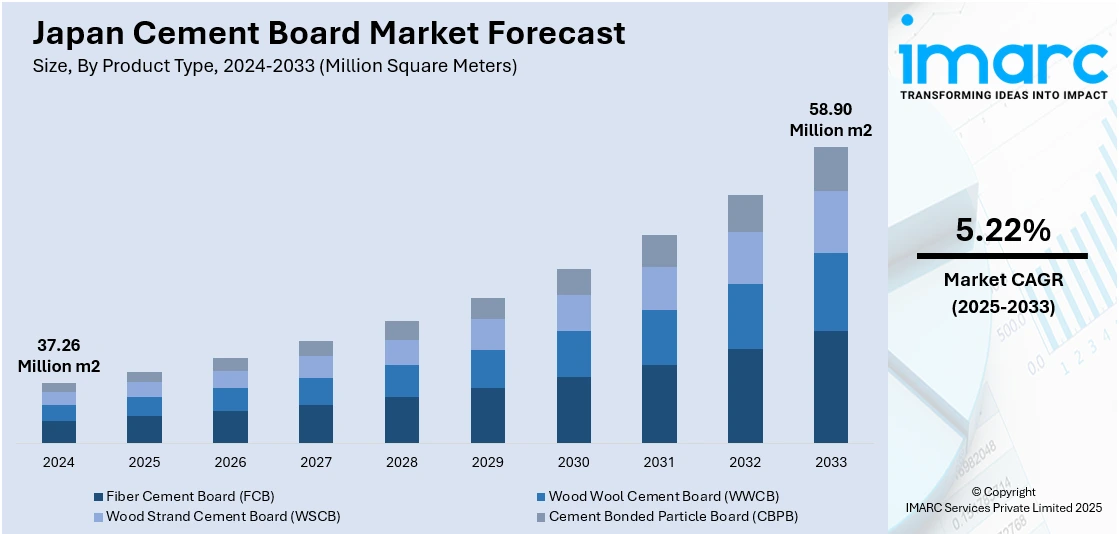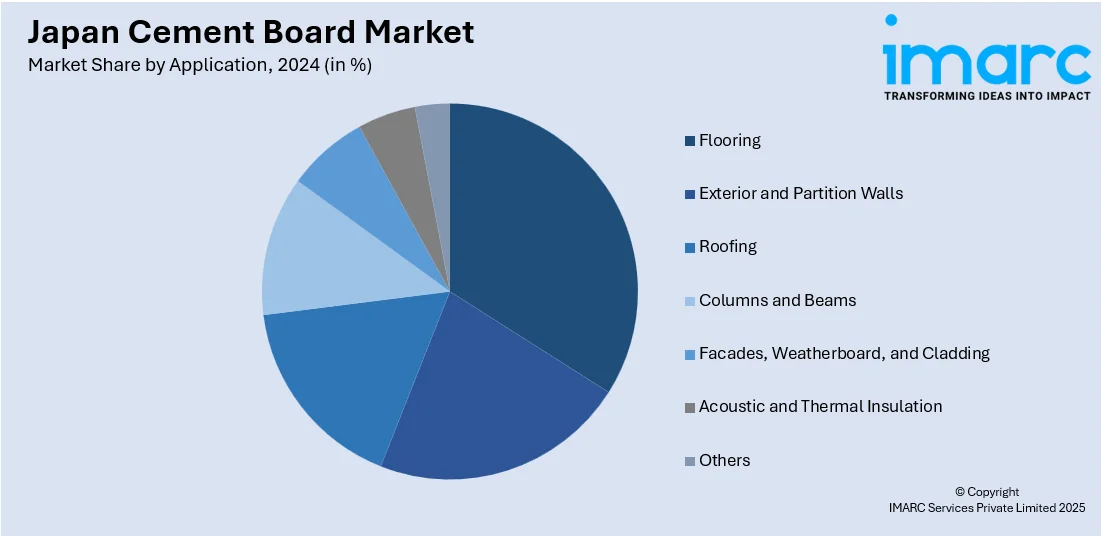
Japan Cement Board Market Size, Share, Trends and Forecast by Product Type, Application, End Use Industry, and Region, 2025-2033
Japan Cement Board Market Overview:
The Japan cement board market size reached 37.26 Million Square Meters in 2024. Looking forward, IMARC Group expects the market to reach 58.90 Million Square Meters by 2033, exhibiting a growth rate (CAGR) of 5.22% during 2025-2033. The market is driven by the rising demand for durable and fire-resistant construction materials, increased construction activities, and the growing focus on sustainable building solutions. Additionally, the expanding infrastructure projects and the adoption of advanced technologies contribute to the growth of the Japan cement board market share.
|
Report Attribute
|
Key Statistics
|
|---|---|
|
Base Year
|
2024 |
|
Forecast Years
|
2025-2033
|
|
Historical Years
|
2019-2024
|
| Market Size in 2024 | 37.26 Million Square Meters |
| Market Forecast in 2033 | 58.90 Million Square Meters |
| Market Growth Rate 2025-2033 | 5.22% |
Japan Cement Board Market Trends:
Advancements in Technology and Product Innovation
Advancements in cement board technology are driving the Japan cement board market. The emphasis is placed on creating high-performance cement boards that offer improved durability, ease of installation, and flexibility in design. With improved production methods, cement boards are now produced in many different textures, sizes, and finishes, making them increasingly useful for a variety of applications, ranging from exterior cladding to interior walls. Additionally, the availability of moisture-resistant and soundproof cement boards is increasing their application in domestic as well as industrial construction. All such product developments, combined with advancements in manufacturing technologies, are driving the demand for cement boards in various industries, driving the overall industry growth in Japan. For instance, in February 2025, Sumitomo Corporation signed a memorandum of understanding with Fortera to explore the feasibility of constructing a low-carbon cement plant in Japan. The project aims to reduce CO2 emissions by 60% during cement production through Fortera's technology. The plant is set for pilot production by 2026, with potential expansion across Asia.

Increased Construction of High-Rise and Commercial Buildings
The rapid urbanization and increased construction of high-rise buildings and commercial structures in Japan are driving the demand for cement boards. For instance, as per industry reports, Japan currently has a high urbanization rate, with over 80% of its population residing in cities. Tokyo, the capital, continues to be one of the most populous cities globally, with a population exceeding 37 million. By 2050, Japan is projected to maintain its urbanization trend, contributing to the global movement towards urban living, where most people will live in cities. Cement boards are widely used in the construction of facades, partitions, and ceilings due to their strength and fire-resistant properties, which are essential for high-rise projects. The growing number of commercial buildings, retail spaces, and residential complexes in urban centers further accelerates the demand for cement boards. With Japan's focus on developing safer and more resilient infrastructure, cement boards are becoming the material of choice for modern construction. This trend is expected to continue, positively impacting the Japan cement board market growth and its share in the broader construction materials sector.
Japan Cement Board Market Segmentation:
IMARC Group provides an analysis of the key trends in each segment of the market, along with forecasts at the country and regional levels for 2025-2033. Our report has categorized the market based on product type, application, and end use industry.
Product Type Insights:
- Fiber Cement Board (FCB)
- Wood Wool Cement Board (WWCB)
- Wood Strand Cement Board (WSCB)
- Cement Bonded Particle Board (CBPB)
The report has provided a detailed breakup and analysis of the market based on the product type. This includes fiber cement board (FCB), wood wool cement board (WWCB), wood strand cement board (WSCB), and cement bonded particle board (CBPB).
Application Insights:

- Flooring
- Exterior and Partition Walls
- Roofing
- Columns and Beams
- Facades, Weatherboard, and Cladding
- Acoustic and Thermal Insulation
- Others
A detailed breakup and analysis of the market based on the application have also been provided in the report. This includes flooring, exterior and partition walls, roofing, columns and beams, facades, weatherboard, and cladding, acoustic and thermal insulation, and others.
End Use Industry Insights:
- Residential
- Commercial
- Industrial and Institutional
A detailed breakup and analysis of the market based on the end use industry have also been provided in the report. This includes residential, commercial, and industrial and institutional.
Regional Insights:
- Kanto Region
- Kansai/Kinki Region
- Central/ Chubu Region
- Kyushu-Okinawa Region
- Tohoku Region
- Chugoku Region
- Hokkaido Region
- Shikoku Region
The report has also provided a comprehensive analysis of all the major regional markets, which include Kanto Region, Kansai/Kinki Region, Central/ Chubu Region, Kyushu-Okinawa Region, Tohoku Region, Chugoku Region, Hokkaido Region, and Shikoku Region.
Competitive Landscape:
The market research report has also provided a comprehensive analysis of the competitive landscape. Competitive analysis such as market structure, key player positioning, top winning strategies, competitive dashboard, and company evaluation quadrant has been covered in the report. Also, detailed profiles of all major companies have been provided.
Japan Cement Board Market News:
- In February 2025, Mitsubishi UBE Cement Corporation (MUCC) invested USD 5 Million in MCi Carbon, which develops mineral carbonation technology for carbon capture and utilization (CCU). This investment supports MCi’s Myrtle demonstration plant in Newcastle, aiming to reduce CO2 emissions in the cement industry and advance sustainability efforts in Japan.
Japan Cement Board Market Report Coverage:
| Report Features | Details |
|---|---|
| Base Year of the Analysis | 2024 |
| Historical Period | 2019-2024 |
| Forecast Period | 2025-2033 |
| Units | Million Square Meters |
| Scope of the Report |
Exploration of Historical Trends and Market Outlook, Industry Catalysts and Challenges, Segment-Wise Historical and Future Market Assessment:
|
| Product Types Covered | Fiber Cement Board (FCB), Wood Wool Cement Board (WWCB), Wood Strand Cement Board (WSCB), Cement Bonded Particle Board (CBPB) |
| Applications Covered | Flooring, Exterior and Partition Walls, Roofing, Columns and Beams, Facades, Weatherboard, and Cladding, Acoustic and Thermal Insulation, Others |
| End Use Industries Covered | Residential, Commercial, Industrial and Institutional |
| Regions Covered | Kanto Region, Kansai/Kinki Region, Central/Chubu Region, Kyushu-Okinawa Region, Tohoku Region, Chugoku Region, Hokkaido Region, Shikoku Region |
| Customization Scope | 10% Free Customization |
| Post-Sale Analyst Support | 10-12 Weeks |
| Delivery Format | PDF and Excel through Email (We can also provide the editable version of the report in PPT/Word format on special request) |
Key Questions Answered in This Report:
- How has the Japan cement board market performed so far and how will it perform in the coming years?
- What is the breakup of the Japan cement board market on the basis of product type?
- What is the breakup of the Japan cement board market on the basis of application?
- What is the breakup of the Japan cement board market on the basis of end use industry?
- What is the breakup of the Japan cement board market on the basis of region?
- What are the various stages in the value chain of the Japan cement board market?
- What are the key driving factors and challenges in the Japan cement board market?
- What is the structure of the Japan cement board market and who are the key players?
- What is the degree of competition in the Japan cement board market?
Key Benefits for Stakeholders:
- IMARC’s industry report offers a comprehensive quantitative analysis of various market segments, historical and current market trends, market forecasts, and dynamics of the Japan cement board market from 2019-2033.
- The research report provides the latest information on the market drivers, challenges, and opportunities in the Japan cement board market.
- Porter's five forces analysis assist stakeholders in assessing the impact of new entrants, competitive rivalry, supplier power, buyer power, and the threat of substitution. It helps stakeholders to analyze the level of competition within the Japan cement board industry and its attractiveness.
- Competitive landscape allows stakeholders to understand their competitive environment and provides an insight into the current positions of key players in the market.
Need more help?
- Speak to our experienced analysts for insights on the current market scenarios.
- Include additional segments and countries to customize the report as per your requirement.
- Gain an unparalleled competitive advantage in your domain by understanding how to utilize the report and positively impacting your operations and revenue.
- For further assistance, please connect with our analysts.
 Request Customization
Request Customization
 Speak to an Analyst
Speak to an Analyst
 Request Brochure
Request Brochure
 Inquire Before Buying
Inquire Before Buying




.webp)




.webp)












